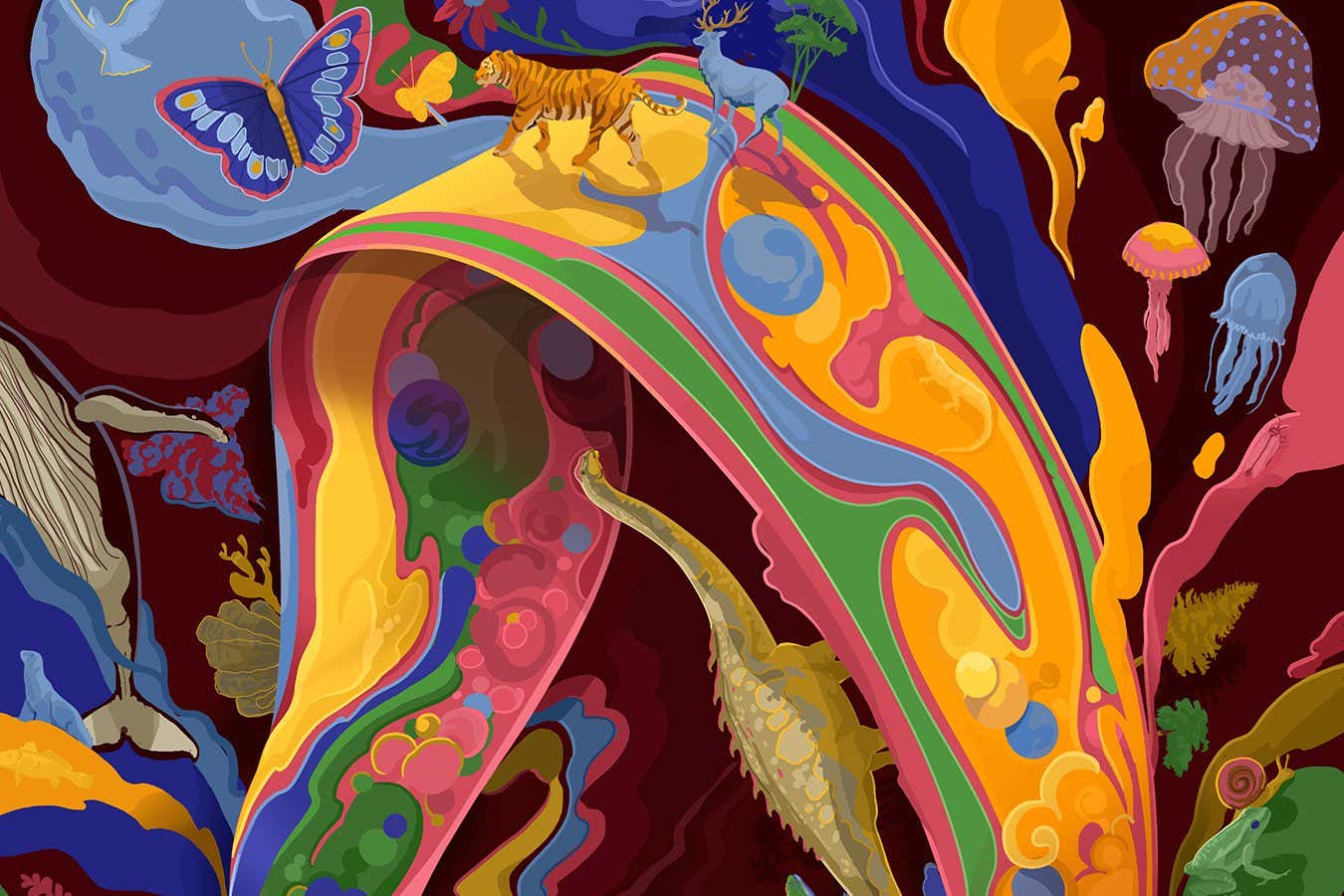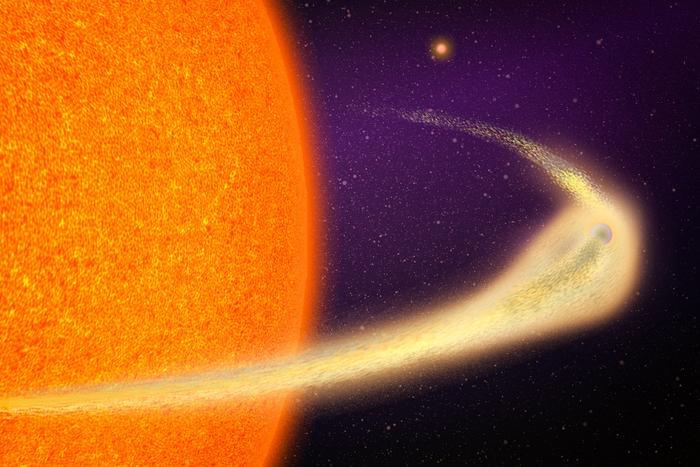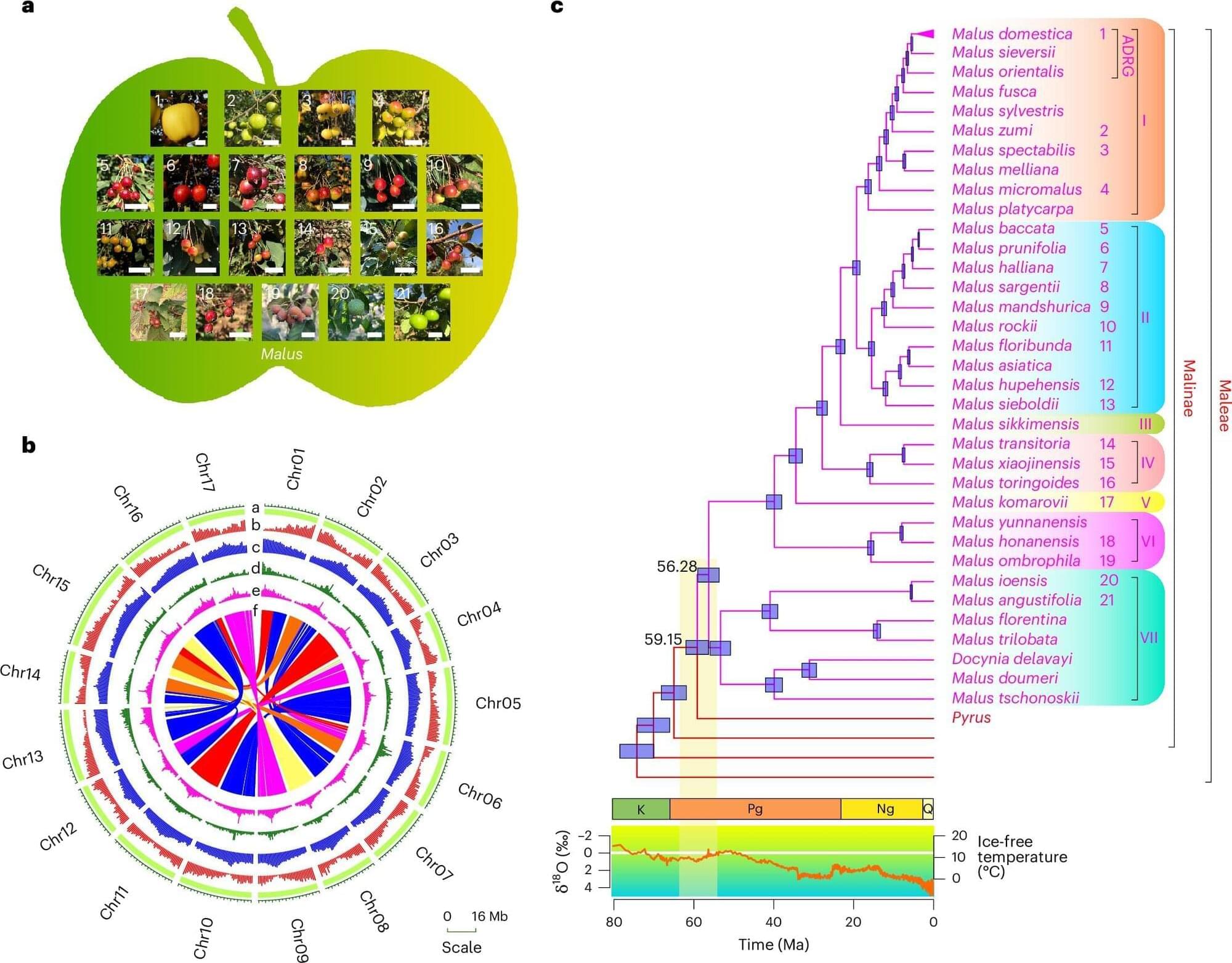Laboratory experiments have coaxed simple molecules into states that naturally become more complex, hinting at the origins of evolution itself



“This is a very tiny object, with very weak gravity, so it easily loses a lot of mass, which then further weakens its gravity, so it loses even more mass,” said Dr. Avi Shporer.
What can a planet that’s shedding its material teach astronomers about planetary formation and evolution? This is what a recently submitted study to The Astrophysical Journal Letters hopes to address as an international team of scientists investigated a unique exoplanet that orbits its host star approximately 20 times closer than Mercury orbits our Sun, resulting in the exoplanet shedding so much material that it’s creating a tail of debris and will eventually disintegrate into nothing.
“The extent of the tail is gargantuan, stretching up to 9 million kilometers long, or roughly half of the planet’s entire orbit,” said Dr. Marc Hon, who is a postdoc in the Kavli Institute for Astrophysics and Space Research at the Massachusetts Institute of Technology (MIT) and lead author of the study.
Exoplanet BD+054868Ab is located approximately 140 light-years from Earth and orbits its star in approximately 30.5 hours. For context, Mercury takes our Sun in 88 days. The orbit of BD+054868Ab is so close, astronomers hypothesize that it’s a molten world slowly shedding its material and they estimate it will be completely gone between 1 million and 2 million years from now. During its long and slow death, BD+054868Ab is shedding so material that it’s leaving a trail of debris in its wake, which initially puzzled astronomers after analyzing data obtained from NASA’s Transiting Exoplanet Survey Satellite (TESS).

Neutrinos, elusive fundamental particles, can act as a window into the center of a nuclear reactor, the interior of the Earth, or some of the most dynamic objects in the universe. Their tendency to change “flavors” may provide clues into the prominence of matter over antimatter in the universe or explain the existence of dark matter.
Physicists are particularly interested in proving the existence of “sterile” neutrinos. Their discovery would reveal a new form of matter that interacts only with gravity and could influence the evolution of the universe.
In a new study published in Physical Review Letters, a team of researchers from U.S. universities and national laboratories has set stringent limits on the existence and mass of sterile neutrinos. While they have yet to find the particles, they now know where not to look.
Eric Lerner is a popular science writer, plasma physicist, and long-time collaborator of the late Nobel laureate Hannes Alfvén. He’s also one of the featured speakers at our Beyond the Big Bang event this summer in Sesimbra, Portugal. For over thirty years, Lerner has been a leading voice in plasma cosmology and a critic of Big Bang cosmology, who argued for a non-expanding, steady state universe as the central claim of his landmark book The Big Bang Never Happened (affiliate link to puchase: https://amzn.to/4jEez8H). Our conversation dives into the history and foundations of plasma cosmology, from early Birkeland current experiments in the Arctic that revealed the electrical nature of the aurora, to the role of plasma dynamics in the shape and behavior of galaxies. All the hits are in here — from Halton Arp, whose Atlas of Peculiar Galaxies seriously challenged the way that mainstream cosmologists interpret redshift, to the electromagnetic forces often overlooked in mainstream cosmology, to the filamentary plasma structures and cosmic-scale currents that strain the limits of the standard model. This is a deep exploration of alternative cosmology, electric universe theories, and the scientists behind them — from Fred Hoyle to Anthony Peratt — who refused to patch a dying theory and instead asked instead if the universe might be eternal.
MAKE HISTORY WITH US THIS SUMMER:
https://demystifysci.com/demysticon-2025
PATREON
/ demystifysci.
PARADIGM DRIFT
https://demystifysci.com/paradigm-dri… Go! 00:05:59 – The Cosmological Pendulum 00:14:09 – Knowledge and Societal Progress 00:22:18 – Big Bang Origins & Ideological Influence 00:29:04 – Technological Stagnation Since the 1970s 00:32:02 – Ideology Replacing Empiricism in Science 00:36:14 – Gravity vs. Electromagnetism in Cosmology 00:41:02 – Evolution of Scientific Funding Models 00:51:11 – Birkeland Currents & Plasma Discoveries 00:56:25 – Centralization of Postwar Science 01:00:18 – Orthodoxy in Medicine 01:00:59 – Decline of Fundamental Research 01:04:39 – Plasma Cosmology vs. Dark Matter 01:08:52 – Capitalism and Research Priorities 01:14:22 – Sustaining Independent Science 01:15:16 – Birkeland, Alfvén & Plasma History 01:22:24 – Einstein’s Rise & Cultural Legacy 01:31:05 – General Relativity and Elitism 01:34:44 – Chapman’s Math vs. Empirics 01:37:12 – Alfvén’s Plasma Breakthroughs 01:43:39 – Plasma Physics vs. Big Bang Theories 01:47:39 – Nobel Prize & MHD’s Hidden Flaws 01:58:00 – Filamentary Plasmas vs. MHD 02:00:47 – Pseudoplasmas and MHD Limits 02:02:58 – Defining Plasma as a State of Matter 02:06:00 – Where Plasma Exists in Nature 02:11:17 – The Myth of Mathematical Models 02:21:10 – Scientific vs. Aesthetic Cosmology 02:29:55 – Failed Big Bang Predictions 02:36:01 – Alternatives to the Expanding Universe 02:43:09 – Large-Scale Structures and Cosmic Age 02:50:10 – Public Science and Open Debate 02:55:16 – Toward a New Cosmological Paradigm #plasma #bigbang #darkmatter #electricuniverse, #cosmology, #astrophysics, #scientificrevolution, #fusionenergy, #philosophypodcast, #sciencepodcast, #longformpodcast ABOUS US: Anastasia completed her PhD studying bioelectricity at Columbia University. When not talking to brilliant people or making movies, she spends her time painting, reading, and guiding backcountry excursions. Shilo also did his PhD at Columbia studying the elastic properties of molecular water. When he’s not in the film studio, he’s exploring sound in music. They are both freelance professors at various universities. PATREON: get episodes early + join our weekly Patron Chat https://bit.ly/3lcAasB MERCH: Rock some DemystifySci gear : https://demystifysci.myspreadshop.com… AMAZON: Do your shopping through this link: https://amzn.to/3YyoT98 DONATE: https://bit.ly/3wkPqaD SUBSTACK: https://substack.com/@UCqV4_7i9h1_V7h… BLOG: http://DemystifySci.com/blog RSS: https://anchor.fm/s/2be66934/podcast/rss MAILING LIST: https://bit.ly/3v3kz2S SOCIAL:
MUSIC:-Shilo Delay: https://g.co/kgs/oty671
00:00 Go!
00:05:59 – The Cosmological Pendulum.
00:14:09 – Knowledge and Societal Progress.
00:22:18 – Big Bang Origins & Ideological Influence.
00:29:04 – Technological Stagnation Since the 1970s.
00:32:02 – Ideology Replacing Empiricism in Science.
00:36:14 – Gravity vs. Electromagnetism in Cosmology.
00:41:02 – Evolution of Scientific Funding Models.
00:51:11 – Birkeland Currents & Plasma Discoveries.
00:56:25 – Centralization of Postwar Science.
01:00:18 – Orthodoxy in Medicine.
01:00:59 – Decline of Fundamental Research.
01:04:39 – Plasma Cosmology vs. Dark Matter.
01:08:52 – Capitalism and Research Priorities.
01:14:22 – Sustaining Independent Science.
01:15:16 – Birkeland, Alfvén & Plasma History.
01:22:24 – Einstein’s Rise & Cultural Legacy.
01:31:05 – General Relativity and Elitism.
01:34:44 – Chapman’s Math vs. Empirics.
01:37:12 – Alfvén’s Plasma Breakthroughs.
01:43:39 – Plasma Physics vs. Big Bang Theories.
01:47:39 – Nobel Prize & MHD’s Hidden Flaws.
01:58:00 – Filamentary Plasmas vs. MHD
02:00:47 – Pseudoplasmas and MHD Limits.
02:02:58 – Defining Plasma as a State of Matter.
02:06:00 – Where Plasma Exists in Nature.
02:11:17 – The Myth of Mathematical Models.
02:21:10 – Scientific vs. Aesthetic Cosmology.
02:29:55 – Failed Big Bang Predictions.
02:36:01 – Alternatives to the Expanding Universe.
02:43:09 – Large-Scale Structures and Cosmic Age.
02:50:10 – Public Science and Open Debate.
02:55:16 – Toward a New Cosmological Paradigm.
#plasma #bigbang #darkmatter #electricuniverse, #cosmology, #astrophysics, #scientificrevolution, #fusionenergy, #philosophypodcast, #sciencepodcast, #longformpodcast.

A new comparison and analysis of the genomes of species in the genus Malus, which includes the domesticated apple and its wild relatives, revealed the evolutionary relationships among the species and how their genomes have evolved over the past nearly 60 million years.
The research team identified structural variations among the genomes and developed methods for identifying genes associated with desirable traits, like tastiness and resistance to disease and cold, that could help guide future apple breeding programs.
A paper describing the research, conducted by an international team that includes Penn State biologists, was published in the journal Nature Genetics.

Researchers from the Institute of Modern Physics (IMP) of the Chinese Academy of Sciences (CAS) have proposed a key indicator that may reveal the emergence of quark-gluon plasma (QGP) by analyzing particle “fingerprints” generated in heavy-ion collisions.
Published in Physics Letters B, the study provides a new perspective for exploring the evolution of matter in the early universe.
About 13.8 billion years ago, within a millionth of a second after the Big Bang, the universe existed in an ultra-hot and dense state. Instead of protons and neutrons, the fundamental building blocks of matter were free quarks and gluons—a unique state known as QGP. As the universe expanded and cooled, the QGP gradually condensed into the atomic nuclei we recognize today.
Join to get access to perks:
https://www.youtube.com/channel/UCmgh6UWmZuJmHZZIGwISCug/join.
Astronomers analyzing Webb’s data have found that early galaxies seem to favor a particular spin direction—an observation that defies the Cosmological Principle. If confirmed, this could suggest that the universe was born with a fundamental rotation, pointing toward radical theories like black hole cosmology.
But this is just the beginning. The telescope has also spotted galaxies forming far earlier than they should have, some potentially dating back to just 168 million years after the Big Bang. These findings contradict existing models of cosmic evolution, raising the possibility that our understanding of time, expansion, and even reality itself may be flawed.
Adding to the mystery, supermassive black holes have been detected in the early universe, defying expectations of how they should form. Could they be remnants of a previous cosmic cycle? Some researchers are now revisiting the Cyclical Universe Theory, which suggests our universe may be part of an infinite loop of creation and destruction.
With every new revelation, JWST is not just answering questions—it’s creating new ones. Are we on the verge of a fundamental shift in physics, or is there a simpler explanation we have yet to uncover?
The James Webb Space Telescope has uncovered some of the most perplexing discoveries in modern astronomy, challenging everything we thought we knew about the cosmos. From galaxies that appear too massive and too developed for their age to a potential imbalance in galactic rotation, these findings are shaking the foundations of the Big Bang model. Could our universe itself have been born inside a black hole?

Miniature zombies are all around us, scuttling through the underbrush or flying through the air in nearly every continent on Earth. In Brazil, a fungus takes over ant brains, altering their circadian rhythms and social behaviors. In England, a virus forces caterpillars to climb high into the canopy, then slowly liquefies their bodies, which drip onto the leaves below. In Indonesia, a parasitoid wasp uses specialized venom to alter a cockroach’s brain chemistry, turning it into the perfect host for her young.
In her new book, Rise of the Zombie Bugs, self-described professional science nerd Mindy Weisberger introduces readers to a menagerie of mind-controlling parasites, and the scientists who have devoted their lives to the study of these peculiar organisms. Through these vivid tales of creatures bizarre enough to rival any fictional beast, Weisberger offers readers a peek into the fields of evolution, ecology, neuroscience, and molecular biology. She shows that these topics exist beyond dim lecture halls and dry textbooks: “Science is everything and everywhere,” she said.


Northeastern University researchers resurrected an extinct plant gene, turning back the evolutionary clock to pave a path forward for the development and discovery of new drugs.
Specifically, the team, led by Jing-Ke Weng, a professor of chemistry, chemical biology and bioengineering at Northeastern, repaired a defunct gene in the coyote tobacco plant.
In a new paper, they detail their discovery of a previously unknown kind of cyclic peptide, or mini-protein, called nanamin that is easy to bioengineer, making it “a platform with huge potential for drug discovery,” Weng says. The paper is published in the journal Proceedings of the National Academy of Sciences.